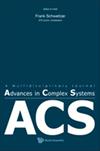Spatial Signatures of Road Network Growth for Different Levels of Global Planning
IF 0.7
4区 数学
Q4 MATHEMATICS, INTERDISCIPLINARY APPLICATIONS
引用次数: 2
Abstract
We compare the statistical distributions of the geometrical properties of road networks for two representative datasets under different levels of planning: the cities comprising Metropolitan Manila show the conditions under bottom-up self-organized growth, while Brasilia and the Australian Capital Territory centered at Canberra represent the case of strict top-down planning. The distribution of segmented areas of the cities shows a dual power-law behavior, with the larger areas following the ∼1.9 scaling exponent observed in other cities, while the smaller areas show a lower exponent of ∼0.5, believed to be due to practical considerations. While all cities are found to favor the formation of straight road segments, the planned city roads have a preponderance of sinuous roads, with sinuosities approaching π. A simple model based on a nearest-neighbor directed branching coupled with sectional grid formations is proposed to capture the nontrivial statistical features observed.全球规划不同层次下路网增长的空间特征
我们比较了两个具有代表性的数据集在不同规划水平下道路网络几何属性的统计分布:包括马尼拉大都会在内的城市显示了自下而上自组织增长的条件,而巴西利亚和以堪培拉为中心的澳大利亚首都直辖区则代表了严格自上而下规划的情况。城市分割区域的分布表现出双重幂律行为,在其他城市中观察到,较大的区域遵循~ 1.9的缩放指数,而较小的区域则显示出较低的~ 0.5的缩放指数,这被认为是出于实际考虑。虽然所有城市都倾向于形成直线路段,但规划的城市道路以弯曲路段为主,弯曲度接近π。提出了一种基于最近邻定向分支与截面网格结构耦合的简单模型来捕捉观测到的非平凡统计特征。
本文章由计算机程序翻译,如有差异,请以英文原文为准。
求助全文
约1分钟内获得全文
求助全文
来源期刊

Advances in Complex Systems
综合性期刊-数学跨学科应用
CiteScore
1.40
自引率
0.00%
发文量
121
审稿时长
6-12 weeks
期刊介绍:
Advances in Complex Systems aims to provide a unique medium of communication for multidisciplinary approaches, either empirical or theoretical, to the study of complex systems. The latter are seen as systems comprised of multiple interacting components, or agents. Nonlinear feedback processes, stochastic influences, specific conditions for the supply of energy, matter, or information may lead to the emergence of new system qualities on the macroscopic scale that cannot be reduced to the dynamics of the agents. Quantitative approaches to the dynamics of complex systems have to consider a broad range of concepts, from analytical tools, statistical methods and computer simulations to distributed problem solving, learning and adaptation. This is an interdisciplinary enterprise.
 求助内容:
求助内容: 应助结果提醒方式:
应助结果提醒方式:


